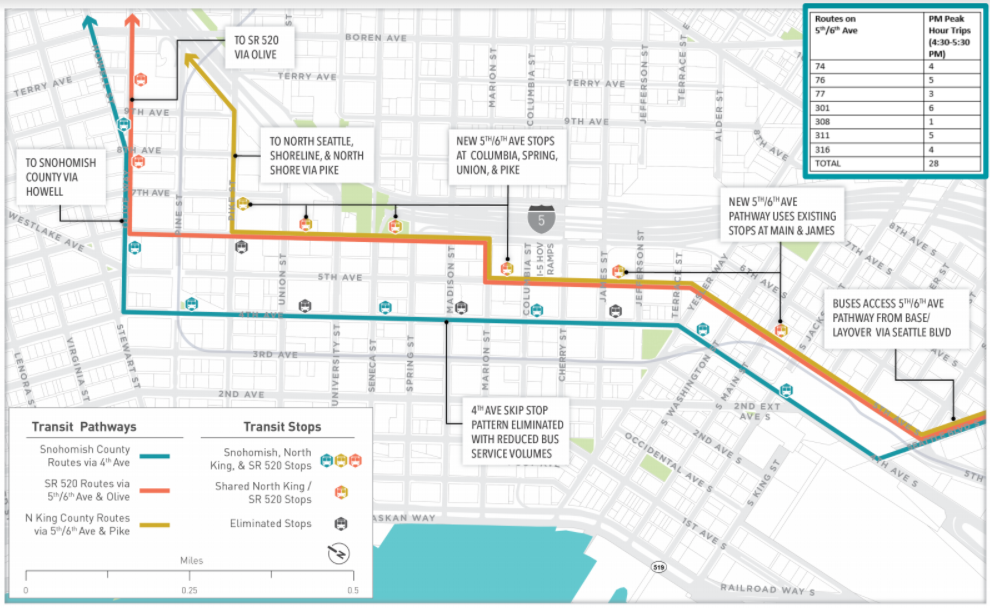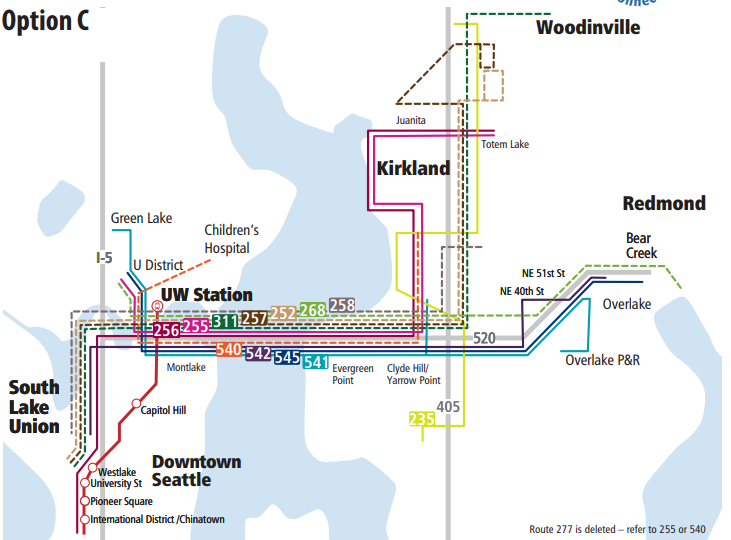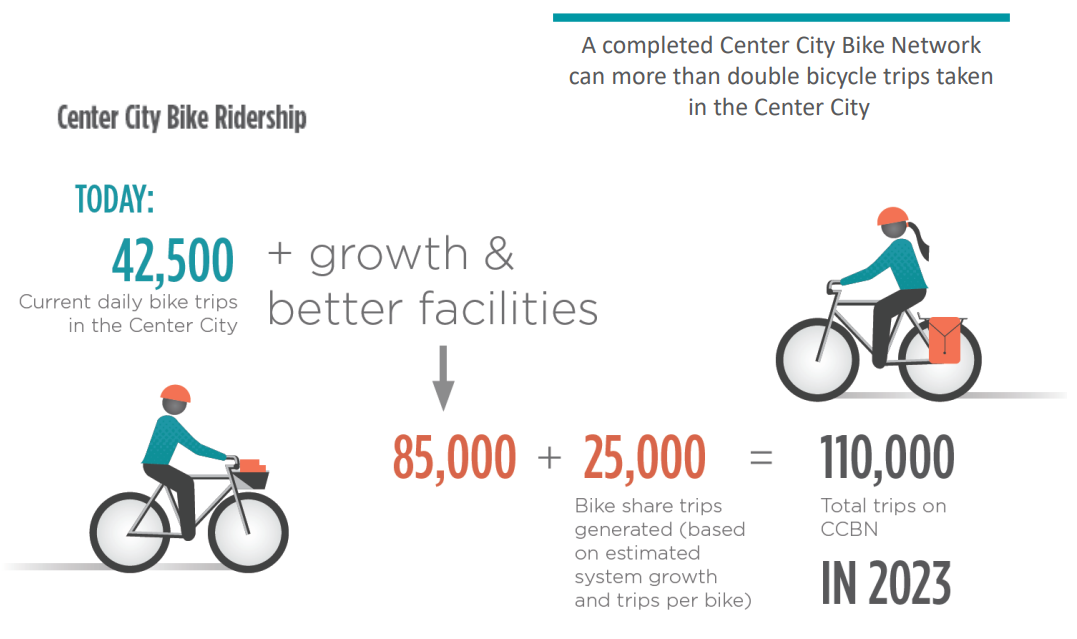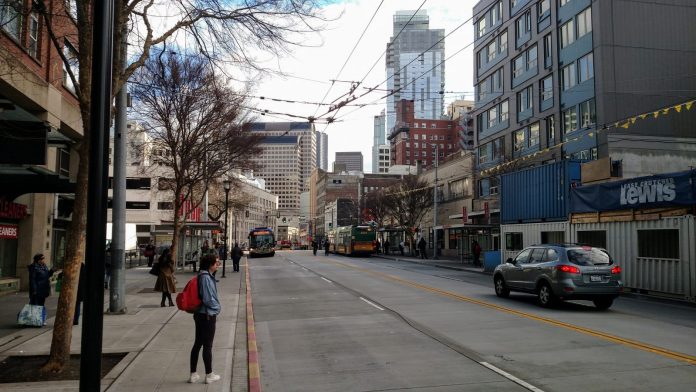When the One Center City Advisory Board delivered its recommendation last September, we applauded the gains for transit priority and the Downtown Basic Bike Network. Five months later, not much else has happened. The advisory group hasn’t met since, the project website has barely been updated, and Seattle Department of Transportation (SDOT) hasn’t added Fourth Avenue protected bike lanes to its 2018 work plan.
Will we avoid the nightmare scenario of commuter buses ejected from the transit tunnel next year clogging Fourth Avenue transit lanes to a crawl, encouraging more people to drive and further worsen Downtown congestion in a downward spiral? It would appear that the advisory recommendation is still the One Center City blueprint even if the precise commitments are unclear and timelines for deliverables are squishy.

“Over the next year, King County and Sound Transit will conduct robust outreach efforts for any potential changes to transit service. The earliest that transit changes would be implemented is fall 2018,” the One Center City Fact Sheet states. Seattle Department of Transportation (SDOT) spokesperson Mafara Hobson said the agency is moving forward with a final decision in “the coming months” but seemed to hint some changes to the recommended near-term projects could be in the works.
“Since the release of these near-term projects, the downtown construction landscape has evolved significantly with the progression of the Center City Connector, new private development, and the impending Viaduct demolition and opening of the SR-99 tunnel just around the corner,” Hobson said. “The new City of Seattle administration, along with the OCC partners, is thoughtfully reviewing the recommended near-term projects to best understand how they’ll impact downtown travelers in light of the intensity of on-the-ground construction challenges and congestion.”
From the beginning, One Center City was designed in anticipation of the alluded to Downtown transportation projects and megaprojects like the Washington State Convention Center Addition, which would replace Convention Place Station. The 2016 Presidential Election played a part in slowing the Madison RapidRide and the Center City Connector streetcar both of which had relied on grants through the New Starts program, which the Trump administration has been slow-walking and trying to dismantle entirely. Not having these transit projects in place as quickly would seem to ramp up the urgency for One Center City rather than call for delays to rethink it.
With Downtown streets headed toward their “period of maximum constraint” in 2019, the One Center City planning process was billed as a way to keep people moving through Downtown by relying more on transit, bicycling, and walking and less on private vehicles. The Downtown Seattle Transit Tunnel (DSTT) will close to buses (likely in September 2019) as Sound Transit prepares for Northgate Link. The opening of that light rail extension in 2021 should relieve some pressure and even more will be relieved by the opening of East Link, Lynnwood Link, and Federal Way Link by 2024. However, in the interim, downtown commuters will be in a pinch.
Even with potential changes to exact near-term projects, the partner transit agencies are trying to hit their deadlines. King County Metro Transit spokesperson Scott Gutierrez fleshed out the timeline in an email.
“Any potential transit service changes associated with One Center City initiatives are currently planned for implementation in September 2019,” Gutierrez said. “Public outreach for potential transit service changes will begin later in spring 2018. Capital elements associated with the OCC Near Term Action Plan will be implemented jointly by the partner agencies, with some elements going into place as early as mid- 2018, and other being delivered through late 2019.”

“The most critical capital elements are currently scheduled to be completed in the first quarter of 2019, corresponding to the earliest date that buses would stop operating in DSTT (March 2019),” Gutierrez added. “Other capital elements will follow.”
One project that may be implemented in 2019 is Metro Transit’s Link Connections 2.0 project around SR-520, which is slated to finish its final phase of outreach this spring. The concept is truncate SR-520 buses at UW Station (where riders would connect to Link light rail) to lessen the strain on Downtown streets and more efficiently use service hours. One downside of the restructure is that it’d make reaching South Lake Union somewhat more cumbersome, requiring a bus connection, a longer walk, or perhaps a bikeshare boost.

A good One Center City plan could turn crisis into opportunity. Reclaiming more downtown street space from private vehicles to create transit lanes and safer pedestrian facilities will continue to be hugely beneficial even after expanded light rail eases the strain on bus lanes. Completing the downtown protected bike network is long overdue, but if One Center City can finally do it, bicyclists would greet it enthusiastically.
Mayor Jenny Durkan gave a nod to continuing trend toward transit and away from private vehicles in her State of the City address in February.
“It’s no secret that our traffic is bad and our buses are full. The bad news is traffic will get worse before it gets better. Mega projects will lead to mega gridlock. The good news is, more people are using transit, and fewer people are driving alone in their cars. We need to keep that trend going,” Mayor Durkan said.
Keeping that trend going will likely involve an ambitious and well implemented One Center City and not just for transit. Increasing pedestrian safety hasn’t been a point of emphasis, but it could pay big dividends, both in lives saved and in encouraging more people to use the lowest impact form of transportation of all, which is Downtown Seattle’s fastest growing mode. The recommended plan relies heavily on increasing bicycling rates downtown to move people more efficiently, as the graphic below shows. The Advisory Group’s stated goal is increasing bicycle trips from an estimated 42,500 per day in 2017 to 110,000 in 2023.

“In fall 2017, the One Center City partners (City of Seattle, King County Metro, Sound Transit and the Downtown Seattle Association) released recommended near-term improvement projects, including management strategies, public realm improvements, new transit and bicycle pathways for 4th, 5th, and 6th Avenues, as well as transit restructures to reduce the number of buses traveling into and through downtown streets,” Hobson said. “These projects reflect the input of the OCC Advisory Group and the public.”
Metro spokesperson Gutierrez said coordinated delivery of the capital projects between partner agencies will be key to the One Center City’s success. “The multi-modal transportation solutions embodied in the OCC Near Term Action Plan rely on joint implementation of all elements in order to maximize use of the transportation system,” he said.
The State Legislature could play an important role, too. House Bill 2403, a bill allowing camera enforcement of transit lanes authored by State Representative Gael Tarleton (D-Seattle), could give One Center City a further boost since traffic cameras would increase compliance with transit-only lanes.
“It is likely that one of the three transit lane enforcement camera pilot projects allowed by HB 2403 would be focused on Third Avenue,” Gutierrez said. “In Metro’s view, such a pilot would significantly reduce violations of transit-only restrictions on Third Avenue and produce benefits for Metro riders, such as improved reliability.”
House Bill 2403 didn’t go anywhere this session, but could be brought back next legislative session. Perhaps certain suburban legislators will have comprehended the value of everyone (yes, suburbanites and tourists, too) following traffic laws in Downtown Seattle. It could be some of One Center City’s success hinges on downtown transit lanes like those on 3rd Avenue not being shortcuts for motorists who feel entitled to slow down bus riders.
So in coming months, bicyclists, transit riders, and pedestrian advocates will watch for all this to come together.
Transit Lane Enforcement Camera Legislation Moves Out of State Committee
Seattle’s Drive Alone Rate Downtown Plummets as Walking to Work Ticks Up
Doug Trumm is publisher of The Urbanist. An Urbanist writer since 2015, he dreams of pedestrian streets, bus lanes, and a mass-timber building spree to end our housing crisis. He graduated from the Evans School of Public Policy and Governance at the University of Washington in 2019. He lives in Seattle's Fremont neighborhood and loves to explore the city by foot and by bike.


